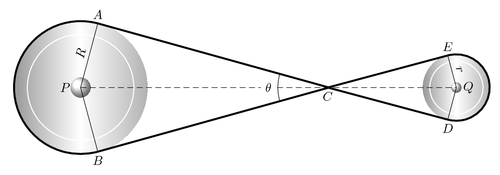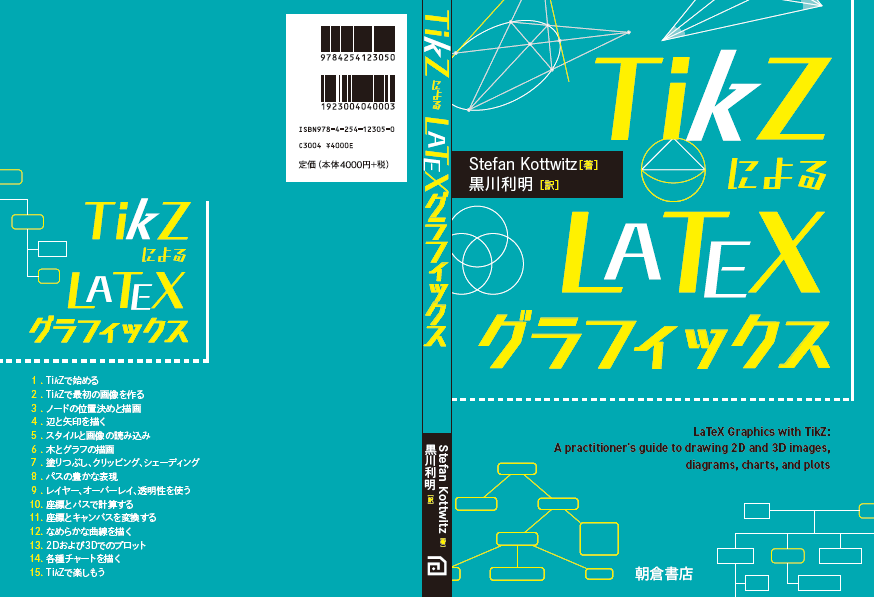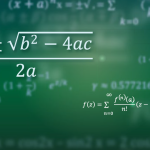This simple belt-and-pulley is used as a basis for solving trigonometric problems. Although simplistic, it shows how elegant and powerful TikZ can be for mathematically precise illustrations. Diagram from Precalculus text by Stewart.

Edit and compile if you like:
% Belt and pulley system
% Author: Jimi Oke
\documentclass[11pt]{article}
\usepackage{tikz}
\usepackage[active,tightpage]{preview}
\PreviewEnvironment{tikzpicture}
\setlength\PreviewBorder{5pt}%
\usetikzlibrary{arrows,shapes,positioning}
\begin{document}
\begin{tikzpicture}
% Definitions
\pgfmathsetmacro{\b}{75}
\pgfmathsetmacro{\a}{15}
\pgfmathsetmacro{\R}{2}
\pgfmathsetmacro{\r}{1}
\pgfmathsetmacro{\P}{\R*tan(\b)}
\pgfmathsetmacro{\Q}{\R/cos(\b)}
\pgfmathsetmacro{\p}{\r/tan(\a)}
\pgfmathsetmacro{\q}{\r/sin(\a)}
% Pulleys
% big pulley
\draw (0,0) circle (\R) ;
\fill[left color=gray!80, right color=gray!60, middle
color=white] (0,0) circle (\R) ;
\draw[thick, white] (0,0) circle (.8*\R);
\shade[ball color=white] (0,0) circle (.3) node[left,xshift=-5] {$P$};
% small pulley
\draw (\Q+\q-.3, 0) circle (\r);
\fill[left color=gray!80, right color=gray!60, middle
color=white] (\Q+\q-.3, 0) circle (\r) ;
\draw[thick, white] (\Q+\q-.3,0) circle (.8*\r);
\shade[ball color=white] (\Q+\q-.3,0) circle (.15)
node[right, xshift=2] {$Q$};
% belt and point labels
\begin{scope}[ultra thick]
\draw (\b:\R) arc (\b:360-\b:\R) ;
\draw (\b:\R) -- ( \P, 0 );
\draw (-\b:\R) -- ( \P, 0 );
\draw (\Q-.3,0) -- + (\a:\p) arc (105:-105:\r) ;
\draw (\Q-.3,0) -- + (-\a:\p);
%\draw (\b:\R) arc (\b:360-\b:\r) ;
\end{scope}
\draw (0,0) -- (\b:\R) node[midway, above,sloped] {$R$} node[above] {$A$};
\draw (-\b:\R)--(0,0) ;
\draw (\Q+\q-.3,0) -- +(105:\r) node[midway,above, sloped] {$r$}
node[above] {$E$};
\draw (\Q+\q-.3,0) -- +(-105:\r) node[below] {$D$};
\node[below] at (-\b:\R) {$B$};
\node[below] at (\Q-.3,0) {$C$};
% center line
\draw[dash pattern=on5pt off3pt] (0,0) -- (\Q+\q-.3,0);
% angle label
\node[fill=white] at (0.73*\Q, 0) {$\theta$} ;
\draw (\Q-1.8,0) arc (180:195:1.5);
\draw (\Q-1.8,0) arc (180:165:1.5);
\end{tikzpicture}
\end{document} Click to download: belt-pulley.tex • belt-pulley.pdf
Open in Overleaf: belt-pulley.tex

